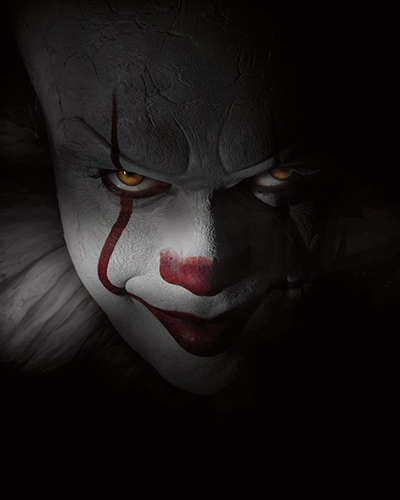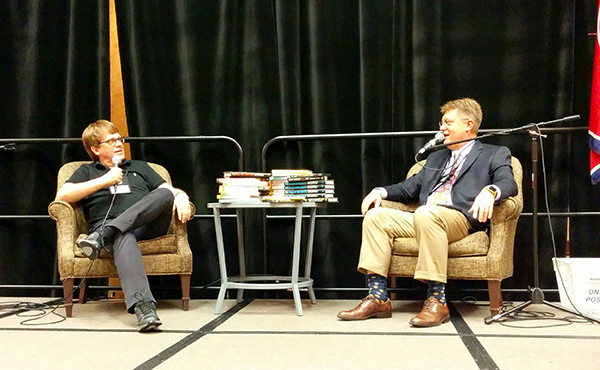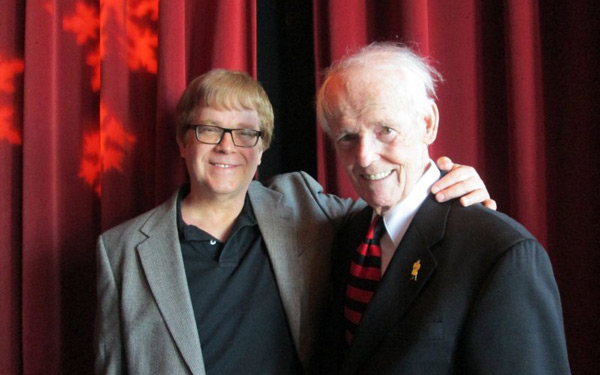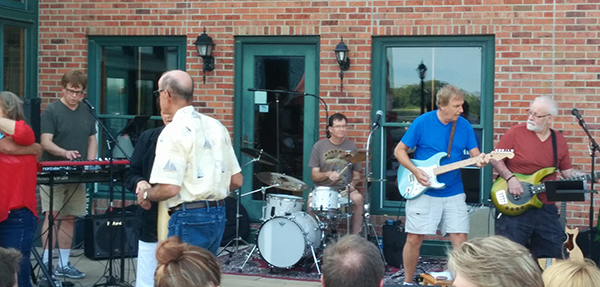
I recently received in the mail from the UK the Arrow Films blu-ray box set of Shock Treatment, the much unloved sort of sequel to Rocky Horror Picture Show. I will now discuss this a little – not in depth, because for you to have access to this, you’d have to have an all-regions blu-ray player, which still isn’t very common (though they are not expensive).
Shock Treatment is high on my list of things that I love that I’m not supposed to. (Also on this list is another movie sequel – the Chinatown follow-up, The Two Jakes.) I am one of the few people you’re likely to run into who saw Rocky Horror in a movie theater on its first run. I was at the time teaching cops English in the Quad Cities (with my back to the firing range at the Davenport PD) and had a long stretch of time between the morning and late afternoon sessions. This I would fill with a movie. So it was that I found myself the only person in a very big theater watching Rocky Horror.
I liked it, and bought the soundtrack (vinyl days). When it became a cult hit, I disliked the talking-back-to-the-screen and dress-up midnight-show screenings, because I actually wanted to hear, see and enjoy the film. That’s how strange I am.
Anyway, Shock Treatment was, on one level, a misguided attempt to create a cult film; its first run in theaters was as a midnight show, and the movie itself was brimming with colorful characters in colorful costumes for Rocky Horror-ites to dress up as.
But it was also a fairly acid criticism by creator Richard O’Brien of America in general and Rocky Horror fans in particular, although you had to be smart to get the latter. Whereas Rocky Horror was about “don’t dream it, be it,” and letting your freak flag fly, Shock Treatment was a critique of everybody wanting to be a star in the “me” decade, which in 1981 had just begun. One of the big production numbers had much of the cast dancing with wheeled full-length mirrors.
Even detractors of Shock Treatment will occasionally admit that the score is at least as good as Rocky Horror and probably better – the soundtrack is a virtual compendium of “New Wave” at its best. I was sold on Shock Treatment going in, because I knew that Janet (of the Brad and Janet duo) was going to be played this time by Jessica Harper, the mesmerizing Phoenix of Phantom of the Paradise, who brought her Karen Carpenter-like alto to all the great Paul Williams music in a film that is on my shortest short list of favorites. And Shock Treatment seems to have been more heavily influenced by Phantom than by Rocky Horror, oddly enough.
Shock Treatment presents the residents of Denton, USA, as the members of a studio audience, who even sleep in that studio. As they watch monitors and live broadcasts, they are caught up in the lives of the various local people who have become the stars of game shows, religious programming and reality TV.
Now here’s the thing: when Shock Treatment was made in 1981, reality TV didn’t exist. Nor did MTV, though the DTV of Shock Treatment seems to be a parody of it, right down to the logo. I had probably seen Shock Treatment fifteen times, easily, on its initial release and later on a laser disc I got from Japan. But I hadn’t watched it in at least ten years.
I had realized the film was remarkably prescient long ago, but seeing it again I was staggered by how much it seemed to be a satire on Trump’s America. It not only predicts and defines MTV and reality television, Shock Treatment includes “selfies,” anti-Mexican Americanism, anti-gay Americanism, and the fast food culture. Most shocking (so to speak) was seeing the movie’s climax in which the much-manipulated studio audience is handed out matching baseball caps with a dumb slogan to wear for the rally-like appearance of a Trump-ish figure whose slick-haired resemblance to Donald Trump, Jr., is downright creepy.
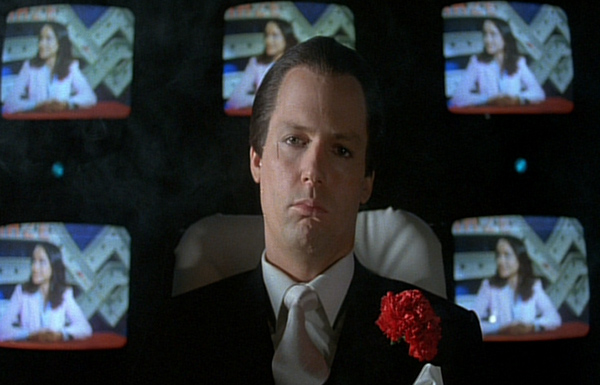
Cliff De Young as…Don Jr.?
This satire of Trump and his followers would seem too on-the-nose and heavy-handed, if it were done today…and not thirty-six years ago.
I don’t expect anybody reading this to send to the UK for the Arrow box set (and Arrow doesn’t have the rights to release the package in the US). But there’s a DVD available, as well as a double feature DVD with Rocky Horror.
Another movie walk-out: The Hitman’s Bodyguard. I am partial to Ryan Reynolds as a quipster, but Samuel Jackson must have really good material to be tolerable, and this one doesn’t have that. The tone is an uneasy combo of extreme, nasty violence and supposed dark humor, with tons of lazy f-wording. We bailed when Reynolds and Jackson, hitchhiking, were picked up by a van that turned out to be transporting cute nuns. Jackson says to the girls, “Whose lap am I going to sit on?” The nuns blush and titter, and we are gone.
Bookgasm has often been very good to me, but this review of Quarry’s Climax rubbed me the wrong way.
Anybody has a right not to like a book, and say so; but this reviewer (who has liked other Quarry novels and has a few nice things to say even here) accuses me of “a disturbing lack of commitment.” That’s a combination of personal insult and mind-reading that goes over the line.
I will counter this review by sharing these Quarry’s Climax reviews with you:
Publisher’s Weekly on Quarry’s Climax:
Booklist on Quarry’s Climax:
is set in the 1970s, when the first Quarry thrillers were written. The hit man with a heart of steel (and a skewed sense of, well, just desserts) is working for the Broker, a murder middleman who farms out hired kills to his operatives. This time it’s a little complicated: Quarry and his partner, Boyd, must first dispatch the hitters sent to eliminate the publisher of the Memphis-based porn mag, Climax; then determine who hired the hitters; and, finally, get rid of them, too. All in a few days’ work for the resourceful Quarry, of course, who developed his killing chops as a Vietnam sniper, but along the way Collins treats us to a wonderfully vivid look at the pornography industry in its heyday. From publishers to centerfolds to strippers to feminist protesters, he cuts through the stereotypes with quick bits of subtle characterization (but, please, don’t say you read a book with Climax in the title only for the characters).
Here’s an interview with the guy who plays Wild Dog on Arrow (still haven’t seen it, but the blu-ray set is on its way).
And finally here’s a Wild Dog podcast.
M.A.C.

